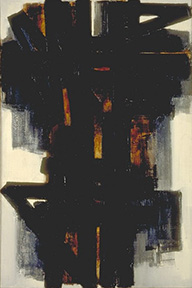After World War II, the center of the Western art world shifted from Paris to New York City. Today, the Abstract Expressionist and Color Field paintings produced by American artists between the late 1940s and early 1960s are known around the world. Less well known are the abstract paintings created by European artists during the same period. After World War II, abstract painting—which had first emerged in pre-World War I Europe—experienced a renaissance on the continent as artists responded to the new developments in American art and also to the postwar social and political situation of Cold War Europe.
From March 11 to May 7, 2017, the Eskenazi Museum of Art will present Abstract Painting in Europe, 1949-1968, curated by Jenny McComas, the Eskenazi Museum of Art's Curator of European and American Art. The works in the exhibition were created between 1949, the year that saw the division of Germany into East and West, and 1968, a year marked by civil and political unrest across the continent, from student and worker uprisings in Paris to anti-Soviet protests in Prague. Ten paintings from the museum's permanent collection—representing artists from Germany, Denmark, the Netherlands, Spain, France, Hungary, and Poland—will be on view in the exhibition. Most of these works have not been shown for decades. This exhibition offers the opportunity to research and reassess these paintings—some of which were among the Eskenazi Museum of Art's earliest acquisitions—and to give the public greater insight into the richness of the museum's holdings.
A free brochure featuring a checklist of works and a scholarly essay by Jenny McComas will be available in the gallery. The essay will place the works on view in their historical, political, and aesthetic contexts.Several public programs will also accompany the exhibition. On Wednesday, March 22, Jenny McComas will present a noon talk in the gallery, "The Politics of Abstract Painting in Postwar Germany," which will focus on the three German paintings (by Ernst Wilhelm Nay, Fritz Winter, and Willi Baumeister) included in the exhibition. On Friday, April 7, a special lecture will be given by Catherine Dossin, Associate Professor of Art History at Purdue University. In her talk, "From Success to Oblivion: Postwar European Artists in the United States 1945-1962," Dossin will discuss the American reception and collecting of European abstract painting in the 1940s and 1950s. Her talk will be followed by a reception at the museum. The next morning, Saturday April 8, the museum's education department will host a Family Day in conjunction with the spring special exhibitions. The program will feature a learning session in the gallery and opportunities to create abstract art inspired by works in the exhibition.
The exhibition is supported by the Doris Steinmetz Kellett Endowed Fund for Twentieth Century Art Collection and the Eskenazi Museum of Art's Annual Fund.



